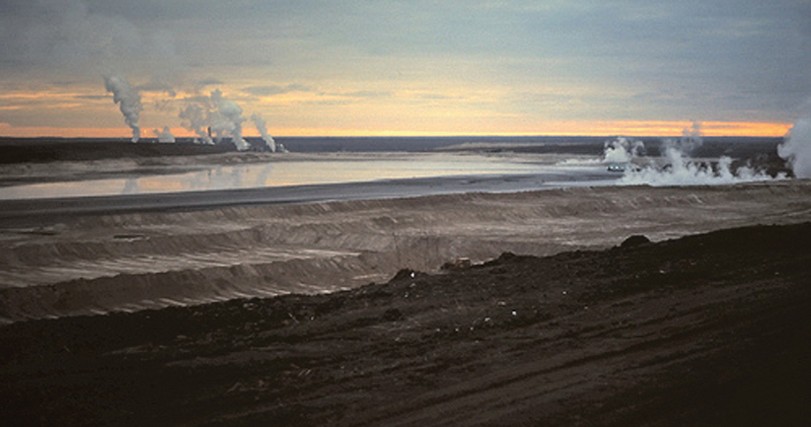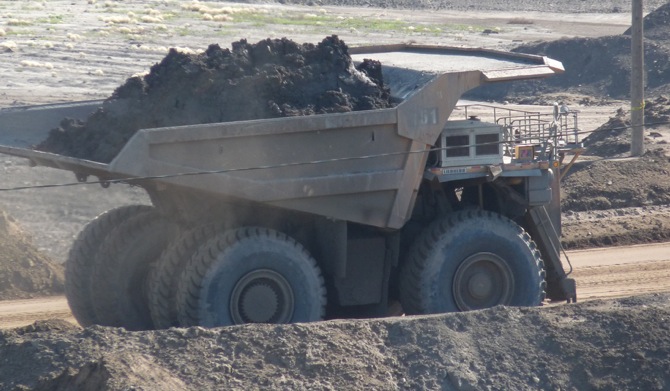
TANNARA YELLAND
Associate News Editor
Underneath the boreal forest in northern Alberta the topsoil and clay give way to an ocean of sand and silt. But this is not like most other sand in the world — this dark, sticky underground expanse has become the cause of one of the largest controversies to strike Canada in recent memory. And in the coming years, we may see the same controversy envelop Saskatchewan.
Even the name of this substance is under debate. Environmentalists often refer to it as “tar sand” and see it as a symbol of all that can go wrong when governments put profits before planning and corporations before constituents. Industry and government workers and others who favour development of the stuff get prickly when they hear “tar sands,” insisting that tar sands and oil sands, their preferred term, are different things altogether.
The pro-oil sands camp sees 170 billion barrels of black gold sitting in the ground, waiting for someone to extract and make it into trillions of dollars. This is the kind of money only bankers, economists and big-business CEOs can wrap their heads around.
Oil sand is a mixture of bitumen, sand and water. Bitumen is a type of unrefined oil. Each grain of sand is covered by a thin layer of water and a layer of bitumen, and to use the bitumen it must be separated from the sand and water. This partially explains why the development of oil sands was delayed until a large portion of the world’s conventional crude was used up — just getting bitumen by itself is a sizeable task, and after that it must be further refined.
According to the government of Alberta’s official oil sands website, “There are 315 billion barrels of potentially recoverable oil in the oil sands,” but about half of this oil cannot be removed until new technology has been developed or the economic climate favours it more. Under current circumstances, 173 billion barrels of oil could be extracted from the oil sands.
This is the second-largest concentration of oil in the world, even without the 142 billion barrels that cannot currently be extracted. Saudi Arabia clocks in at number one with 264 billion barrels of oil, and Iran is third with 136 billion barrels.
Three billion barrels have already been extracted since development of Alberta’s oil sands began in the late ’60s, at a current rate of slightly over one million barrels per day. The Alberta government hopes to expand this number by 2018 to three million barrels per day.
The phrase “one million barrels of oil” is somewhat misleading, though, because it is not equivalent to one million barrels of oil sand. It takes two tonnes of oil sand to produce one standard-size 42-gallon barrel of oil.
There are two main methods employed when extracting bitumen from the ground. The conventional open-pit mining process, wherein a company digs a large hole and carts out usable material en masse, can be employed if the oil sand is close enough to the surface. However, most of Alberta’s oil sand is too far below the ground for this to work.
When mining is not feasible, a process called “in situ” is used. In situ means in place, and refers to the fact that the sand remains in the ground. Hot steam is injected into the ground to heat up the bitumen, which, when hot enough, bubbles up to the surface, no longer attached to grains of sand.
As recently as 2008 the split between the oil recoverable by in situ and mining was 55 per cent and 45 per cent respectively. But because mining is far less expensive and the oil sand is easier to reach, that number has already changed dramatically. Of the oil sands remaining in Alberta, 80 per cent is recoverable by in situ and 20 per cent by mining.

This presents some problems. While in situ extraction does not create open pits like mining does, which accounts for some of the environmental concerns to be detailed, greenhouse gas emissions for in situ extraction and upgrading are 3.5 to 4.2 times higher than for production of conventional crude oil.
Preston McEachern, section head for science, research and innovation at the Alberta Environment Oil Sands Division, pointed out that in situ extraction “is actually incredibly low on the terrestrial disturbance side.” Whereas mining operations leave huge open pits, in situ requires only a series of pipelines and well pads (cleared areas that have paired wells, generally 16 pairs).
But Marc Huot of the Pembina Institute, a non-profit think tank focused on sustainable energy, feels this still presents a land-disturbance problem, albeit of a different sort.
“Fragmentation of forests is a big concern,” Huot said. “An in situ facility will be made of a large network of wells, pipelines, et cetera that are spread out over a large area of the forest”¦. A lot of the wildlife (in the area), like caribou, are very sensitive to development,” and even minor changes in their environments.
The issues raised by those opposed to oil sands development are many and varied, though a large portion of them are related to the environment.
Huot, an oil sands technical and policy analyst, said one of the major concerns is something known as a “tailings pond,” in which the leftover sand and water are deposited after the bitumen is separated from them.
“There’s a whole mix of chemicals that are in tailings,” Huot said. “It’s a mix of water, sand, some hydrocarbons, arsenic, polycyclic aromatic hydrocarbons”¦ some of these are carcinogenic.”
According to both Huot and McEachern, tailings ponds are built on bare ground — a hole is dug in the ground and tailings are placed in the hole. McEachern said that while these are “not impermeable,” there are structures set up to capture any seepage, at which point it is placed back in the pond.
Additionally, McEachern said the government does “extensive monitoring of surface water,” including sampling the Athabasca River. This monitoring has shown that there has been no change in the level of contaminants in the Athabasca River, McEachern says.
However, Huot pointed out that this does nothing to mitigate the problem of water seeping out the bottom of these ponds and into the groundwater.
“In the Athabasca region the groundwater is all very connected,” Huot said. “The seepage is kind of going in every direction down and underneath (tailings ponds), so if they’re checking the surface water that’s not really checking what’s going on underneath.”
Alberta’s government is mainly concerned with recycling water as opposed to dealing with the dangerous chemicals present in tailings despite Alberta Environment Minister Rob Renner’s admission that consolidated (solid) tailings are “more or less” the same as fluid tailings, and thus contain the same dangerous chemicals.
“The difference,” Renner said, “is that they’re much more stable, so that means they’re far less likely to cause any kind of problems associated with leeching and seepage.”
Because they will not likely leech or seep into surrounding groundwater, consolidated tailings will be used in the process of “reclaiming” land, returning it to a sustainable state.
“You have to fill in the (mine) hole,” McEachern said of the tailings’ use. Once former mining pits have been filled with consolidated tailings they can be covered with topsoil and trees can be planted on top.
It remains to be seen whether the carcinogenic chemicals in the ground will have any negative effect on the vegetation or animal life.
The Alberta government’s claim that all disturbed land will be returned “to what it was before,” as McEachern phrased it, belies an important qualification.
“Reclamation is going to look different” from the undisturbed land, Huot said. “Things like bogs and fens take thousands of years to form.”
Bogs and fens comprise between 40 and 60 per cent of northern Alberta, according to McEachern. When the landscape is returned to “native ecotypes,” as it must be after companies are done with it, there will be significantly more boreal forest, though McEachern says this will not be detrimental to the environment.
“We’re still going to see wetlands,” he said. “They’re just not going to be half a metre of peat. (They’ll be) more like reed or cattail wetlands, like you have in Saskatchewan, with lots of emergent vegetation”¦. The hydrology’s completely changed (after mining), so you can’t have a bog.”
While unable to compare with Alberta’s massive store of bitumen, Saskatchewan has an estimated 2.3 billion barrels of bitumen under its northern forests. A few companies have begun exploration into Saskatchewan’s oil sands to see if they would be worth investing in, “in the absence of a regional land use plan and before regional environmental monitoring is in place or rules to protect air, land and water have been identified,” according to a Pembina Institute fact sheet.
All of Saskatchewan’s deposits must be extracted in situ, as they are too far underground to be mined. And as of 2007 Saskatchewan already has the highest per capita GHG emissions in the world, at 72 tonnes per person. Qatar, the country with the highest per capita emissions, emitted 66.6 tonnes per person in 2005.
One of Huot’s biggest worries is about the lack of publicly available information surrounding most, if not all, aspects of the environmental impact of oil sands. Linda Duncan, who represents the Edmonton-Strathcona riding as Alberta’s only NDP Member of Parliament, agrees with Huot, saying studies that should have been completed before development are still happening.
“We’re doing a hearing on the effects of oil sands development on water and we haven’t finished this hearing, and yet we’re continuing to rubber-stamp these projects,” she said.
Renner says that, quite apart from there being too little public information, there is an “overwhelming” amount, but that it is far too technical for most people to grasp.
– –